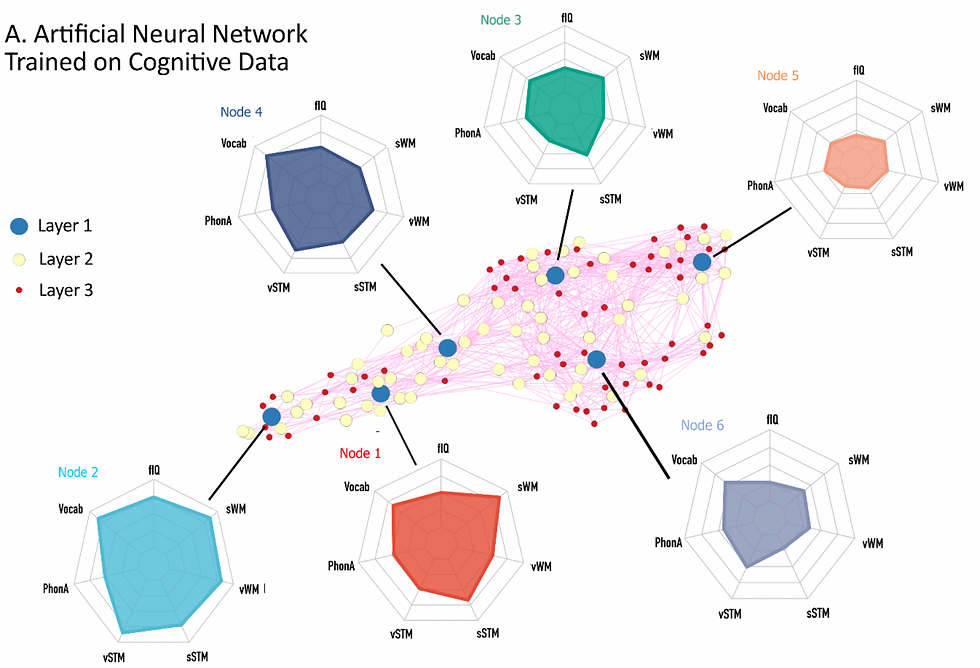No ‘core brain deficit’ underpinning learning difficulties
- Feb 20, 2020
- 4 min read
Updated: Feb 27, 2020
Is the developing brain linked to children's learning difficulties, and if so how? This is the question we asked in our latest paper:
Siugzdaite, R, Bathelt, J, Holmes, J, & Astle, D
Current Biology (online on 27 02 2020 4pm)

Between 14-30% of children and adolescents worldwide are living with a learning-related problem sufficiently severe to require additional support according to data from the Department for Education and National Centre for Education Statistics in 2019. But why can learning be a challenge for these children?
CALM - A transdiagnostic approach to studying struggling learners
Traditionally struggling learners have been studies according to their diagnosis, usually with some sort of comparison group. For example, what are the brain mechanisms associated with ADHD versus children without ADHD?
In 2014 a new research 'clinic' was formed at the MRC Cognition and Brain Sciences Unit in Cambridge. This clinic was a partnership between multiple research groups, hundreds of families and hundreds of practitioners in children's professional services. Over 800 children were referred to the clinic by specialists in educational or clinical services, and they could have one, multiple or no diagnoses. During their visit children undertook multiple cognitive assessments, learning measures, questionnaires, brain scans and provided a DNA sample. You can find out more about the full dataset by reading the CALM protocol paper.
We wanted to try and map differences between children's cognitive abilities to brain differences. We explored structural brain properties – morphology - the thickness of the grey matter layer, gyrification and sulci depth, and whether and how these features related to a child's cognitive difficulties.
How did we do it?
We used a simple type of machine learning called an artificial neural network (ANN). First we fed cognitive data from almost 500 CALM children into the ANN. The algorithm was able to learn that there were different cognitive profiles within the cohort. We used a process called 'cross-validation' to show that these profiles were significantly associated with children's learning abilities.
Cognitive Profiles
The cognitive profiles can be broadly characterised by six different groupings - represented by the network as 'nodes'. These included children with good cognitive skills (Nodes 1,2 and 4), children with poor listening skills (Node 3), children poor executive skills (e.g. planning, Node 6) and children with widespread cognitive difficulties (Node 5).

Brain Profiles
The same procedure was repeated for brain data. We introduced structural brain imaging data from the same children to the same type of algorithm. So this time the ANN was representing differences in children's brain profiles.
Brain-Cognition Mapping
With these two types of representation - cognitive profiles and brain profiles - we next wanted to test how these map onto each other. The answer was that there were significant relationships between cognitive and brain profiles, but these relationships were not strong. In fact we were only able to find them because our sample was so big. To provide a specific example, with a child's brain scan we were able to predict their cognitive profile about 6% more accurately than chance.
This is because each cognitive profile is linked to multiple brain profiles and vice versa. In other words, children with very different brains can end up with the same cognitive difficulties, and children with apparently very similar brains can end up with very different cognitive difficulties.

Brain as a network...
Maybe the important thing about kids' brains isn't related to specific regions or areas... but instead to how those areas are wired together. Think about other complex systems, like subway. Some places are hubs in the network (e.g. King's Cross within the London Tube network). When they shut unexpectedly it can have a catastrophic effect on the whole network. This is true for all sorts of networks, even social networks. It is true of the brain also; hubs play a key role in making sure that information can pass between different brain regions.
In our cohort of children we also had data about the white matter connections between these brain regions. These were used to create whole-brain connectomes for each child - these are a bit like a wiring map, showing which areas are connected and how strongly.
Some children had brains that were strongly organised around hubs. We found this out because if we removed the hubs from their 'wiring map' then the overall efficiency of their brain networks dropped massively. By contrast, some children relied less on their hubs. And crucially, these differences across children were very strongly related to their cognitive ability. The 'hubbiness' of a child's brain was a strong predictor of their cognitive profiles.

What did we find?
1. There are no specific brain areas that cause a particular disorder or difficulty.
Regional brain data about specific areas were not strongly linked to cognitive abilities, and were certainly not predictive of having a diagnosis of ASD or ADHD. The same cognitive profile could be linked with multiple brain profiles and vice versa.
2. It is far more important to consider how these brain areas are connected.
We found that children’s brains were organised around hubs– like an efficient transport network. Children with well-connected brain hubs had either very specific cognitive difficulties or no cognitive difficulties at all. By contrast, children with poorly connected hubs – like airports with poor connectivity – had widespread and severe cognitive problems.
Why is this important?
This suggests we need a radical rethink about how the brain is related to children's cognitive difficulties, and thus the mechanisms at play. For example, what other biological or environmental factors will influence the emergence of these hubs? Are some hubs more crucial for some cognitive skills?
It also underscores that a child's diagnosis is not a good predictor of their cognitive difficulties or of the underlying brain mechanisms. And we need to take this seriously when we consider how we support children who are struggling.
Comments